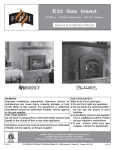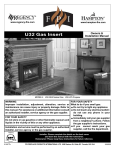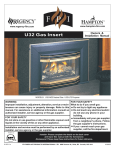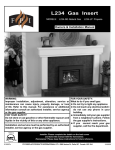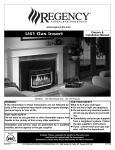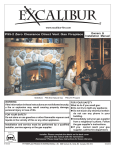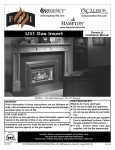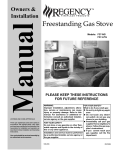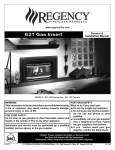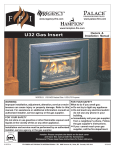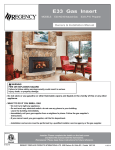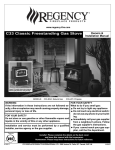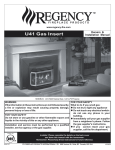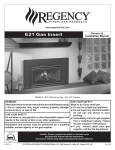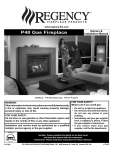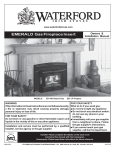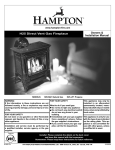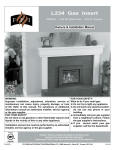Download Regency E33-LP User's Manual
Transcript
E33 Gas Insert MODELS: E33-NG Natural Gas E33-LP Propane Owners & Installation Manual WARNING: FOR YOUR SAFETY: Improper installation, adjustment, alteration, service or main- What to do if you smell gas: tenance can cause injury, property damage, or loss of life. Do not try to light any appliance Refer to this manual. For assistance or additional informaDo not touch any electrical switch: tion consult an authorized installer, service agency or the do not use any phone in your buildgas supplier. ing. FOR YOUR SAFETY: Immediately call your gas supplier Do not store or use gasoline or other flammable vapours and from a neighbour's phone. Follow liquids in the vicinity of this or any other appliance. the gas supplier's instructions. If you cannot reach your gas supInstallation and service must be performed by an authorized plier, call the fire department. installer, service agency or the gas supplier. Tested by: Installer: Please complete the details on the back cover and leave this manual with the homeowner. Homeowner: Please keep these instructions for future reference. 918-408 FPI FIREPLACE PRODUCTS INTERNATIONAL LTD. 6988 Venture St., Delta, BC, Canada V4G 1H4 08/16/05 FPI GAS FIREPLACE INSERT TO THE NEW OWNER Congratulations! You are the owner of a state-of-the-art Gas Insert by FPI. The E33 Gas Insert has been designed to provide you with all the warmth and charm of a fireplace, at the flick of a switch. The E33-NG and E33-LP have been approved by Warnock Hersey for both safety and efficiency. As it also bears our own mark, it promises to provide you with economy, comfort and security for many trouble free years to follow. Please take a moment now to acquaint yourself with these instructions and the many features of your FPI Fireplace. 32-1/4"(819mm) 16-1/8"(410mm) 24-1/2"(622mm) 23-13/16"(605mm) 18"(203mm) 31-1/8"(790mm) 25"(635mm) 1-3/8" (35mm) 11-1/4" (286mm) 23"(583mm) 45-9/16"(1157mm) 16-1/2"(419mm) 2 E33 FPI Direct Vent Gas Insert TABLE OF CONTENTS FPI GAS FIREPLACE INSERT Page Page OPERATING INSTRUCTIONS Unit Dimensions ..................................................................... 2 Safety Label .......................................................................... 4 INSTALLATION REQUIREMENTS For Your Safety ....................................................................... 5 Gas Pressure Testing ............................................................. 5 Specifications ......................................................................... 5 Installation into a Solid Fuel Burning Fireplace or Factory Built Fireplace ................................ 5 General Safety Information .................................................... 5 Installation Checklist ............................................................... 6 Materials Required ................................................................ 6 Minimum Fireplace Dimensions ............................................. 6 Clearances to Combustibles .................................................. 7 Combustible Mantel Clearances ............................................ 7 INSTALLATION Gas Connection ...................................................................... 8 Venting .......................................................................... 8 Flue Liner Installation ............................................................. 8 Gas Pipe Pressure Test .......................................................... 9 SIT Valve Description ............................................................ 9 Gas Insert Aeration System .................................................... 9 Optional Brick Panel .............................................................. 9 Log Installation .................................................................... 10 E33 Conversion Kit from NG to LPG .................................... 12 Faceplate & Trim .................................................................. 13 Standard Flush Door ............................................................ 14 Flush Louvers ....................................................................... 14 Full Screen Front .................................................................. 14 Excalibur Surround Installation ............................................. 15 Optional Screen Doors ......................................................... 16 Accent Kit Installation ........................................................... 16 Double Door Option .............................................................. 16 Wiring Diagram ..................................................................... 17 Optional Remote Control ..................................................... 17 Optional Wall Thermostat ..................................................... 17 Final Check ........................................................................ 18 E33 FPI Direct Vent Gas Insert First Fire ........................................................................ 18 Operating Instructions .......................................................... 18 Lighting Procedure ............................................................... 18 Shutdown Procedure ............................................................ 18 Copy of Lighting Instruction Plate ......................................... 19 Automatic Convection Fan Operation .................................. 19 Normal Operating Sounds of Gas Appliances ...................... 19 MAINTENANCE Maintenance Instructions ..................................................... 20 General Vent Maintenance .................................................. 20 Log Replacement ................................................................. 20 Glass Gasket ....................................................................... 20 Steel or Gold Plated Trim ..................................................... 20 Door Glass ........................................................................ 21 Flush Glass Replacement .................................................... 21 Fan Maintenance .................................................................. 21 Valve Assembly Removal and Installation ........................... 22 REPLACEMENT PARTS LIST Parts List ........................................................................ 23 WARRANTY Warranty ........................................................................ 31 3 SAFETY LABEL This is a copy of the labels that accompany each E33 Gas Insert. We have printed a copy of the contents here for your review. The safety label is located on a plate inside the base of the unit visible when the bottom louver is opened. Ensure that the safety label is attached to the unit. NOTE: FPI units are constantly being improved. Check the label on the unit and if there is a difference, the label on the unit is the correct one. For the State of Massachusetts, installation and repair must be done by a plumber or gasfitter licensed in the Commonwealth of Massachusetts. For the State of Massachusetts, flexible connectors shall not exceed 36 inches in length. For the State of Massachusetts, the appliances individual manual shut-off must be a t-handle type valve. 4 E33 FPI Direct Vent Gas Insert INSTALLATION IMPORTANT: SAVE THESE INSTRUCTIONS The FPI Gas Fireplace must be installed in accordance with these instructions. Carefully read all the instructions in this manual first. Consult the building authority having jurisdiction to determine the need for a permit prior to starting the installation. NOTE: Failure to follow the instructions could cause a malfunction of the heater which could result in death, serious bodily injury, and/or property damage. Failure to follow these instructions may also void your fire insurance and/or warranty. FOR YOUR SAFETY This appliance requires air for proper combustion. Always provide adequate combustion and ventilation air. Follow instructions and information in CSA B149.1 (in Canada) or the National Fuel Gas Code ANS Z223.1/NFPA (in the USA), regarding requirements for combustion and ventilation air. GAS PRESSURE TESTING The appliance must be isolated from the gas supply piping system by closing its individual manual shut off valve during any pressure testing of the gas supply piping system at test pressures equal to or less than 1/2 psig. (3.45 kPa). SPECIFICATIONS At pressures over 1/2 psig, the pipe to the unit must be disconnected. Gas Input Capacity: Natural Gas 38,000 Btu/h Propane 35,500 Btu/h Min. Input: Natural Gas 20,000 Btu/h Propane 19,000 Btu/h Fuels: Approved for use with both natural gas, and propane. Approved as is for use at 0' to 4,500' (0-1370m). Electrical: 120V A.C. system. Circulation Fan: Variable speed, 127 CFM. Log Set: Ceramic fibre, 8 per set. Vent System: 3" co-linear aluminum flex. E33 FPI Direct Vent Gas Insert INSTALLATION INTO A SOLID FUEL BURNING FIREPLACE OR FACTORY BUILT FIREPLACE The E33 Gas Inserts have been tested and approved to be vented into any masonry fireplace or approved solid fuel burning factory built fireplace that will allow the insert to physically fit into the firebox. Refer to page 6 for minimum fireplace clearances. If the factory built fireplace* height is too low for your Insert, you may remove the smoke baffle plate and damper from the factory built fireplace as long as these items are saved and are reinstalled in the event that the Insert is removed. NOTE: Any alterations made to the listed solid fuel burning factory built fireplace may void the listing of the fireplace. Cutting any sheet-metal parts of the fireplace, in which the gas fireplace insert is to be installed, is prohibited. If the factory-built fireplace has no gas access hole(s) provided, an access hole of 1.5" (37.5mm) or less may be drilled through the lower sides or bottom of the firebox in a proper workmanship like manner. This access hole must be plugged with non-combustible insulation after the gas supply line has been installed. The fireplace and fireplace chimney must be clean and in good working order and constructed of non-combustible materials and chimney cleanouts must fit properly. Refractory, glass doors, screen rails, screen mesh, and log grates can be removed from the fireplace before installing the gas fireplace insert. Smoke shelves, shields and baffles may be removed if attached by mechanical fasteners. A tight connection between the gas fireplace insert flue collar and the fireplace chimney must be made. *Check with your local inspector before commencing with this installation. BEFORE YOU START Safe installation and operation of this appliance requires common sense, however, we are required by the Canadian Safety Standards and ANSI Standards to make you aware of the following: General Safety Information 1) The appliance installation must conform with local codes or in the absence of local codes, with CAN/CSA B149.1 (in Canada) or the National Fuel Gas Code ANSI Z223.1 NFPA 54 in the U.S.A. This appliance should be installed by a qualified gas fitter technician only. 2) Installation and repair should be done by a qualified service person. 3) The appliance should be inspected before use and at least annually by a professional service person. More frequent cleaning may be required due to excessive lint from carpeting, bedding material, animal hair, etc. It is imperative that control compartments, burners and circulating air passageways of the appliance be kept clean. 4) See general construction and assembly instructions. This appliance may only be installed in a vented, noncombustible fireplace. 5) This appliance is Listed for bedroom installations when used with a Listed Millivolt Thermostat. Some areas may have further requirements, check local codes before installation. 6) Always connect this appliance to a vent system vent that is run (or routed) to the outside of the building envelope. Never vent to another room or inside a building. Make sure that the vent is properly sized and is of adequate height to provide the proper draft. 7) Inspect the venting system annually for blockage and any signs of deterioration. 8) Any glass removed for servicing must be replaced prior to operating the appliance. 9) WARNING: Failure to position the parts in accordance with the diagrams in this manual or failure to use only parts specifically approved with this appliance may result in property damage or personal injury. 10) To prevent injury, do not allow anyone who is unfamiliar with the operation to use the fireplace. 5 INSTALLATION 11) Due to high temperatures, the appliance should be located out of high traffic areas and away from furniture and draperies. Children and adults should be alerted to the hazards of high surface temperatures, especially the fireplace glass, and should stay away to avoid burns or clothing ignition. Young children should be carefully supervised when they are in the same room as the appliance. Clothing or other flammable material should not be placed on or near the appliance. Emissions from burning wood or gas could contain chemicals known to the State of California to cause cancer, birth defects or other reproductive harm. INSTALLATION CHECKLIST Before installing vent system ensure that the damper plate is open and secure to prevent the damper plate from falling down and crushing the liner. The FPI Gas Insert is installed as listed below. 1) Check all clearances to combustibles, see page 7. 2) Make the gas connection. See page 8. 3) Install the 3" flue liner to the sliding connector plate. See page 8. 4) Slide the unit half way into the fireplace. 14) Install optional Excalibur Surround. See page 15. 15) Install optional remote control or wall thermostat, pages 17. 16) Final check (page 18): Before leaving this unit with the customer, the installer must ensure that the appliance is firing correctly. This includes: a) Clocking the appliance to ensure the correct firing rate. b) Adjusting the primary air, if required, to ensure that the flame does not carbon. See page 9. c) Ensuring that the appliance is venting correctly. 7) Test gas pressure, page 9. Check aeration system, page 9. 8) Install the optional brick panels. See page 9. 9) Install the log set. See page 10. 10) Assemble and install the faceplate and trim. See page 13. The minimum fireplace opening for the FPI gas fireplace insert is shown in the following diagrams: MATERIALS REQUIRED No electrical power supply is required for the gas control to operate. A 120 Volt AC power cord is hooked up to the fan. Plug the 3 wire cord into a suitable receptacle. Do not cut the ground terminal off under any circumstances. When connected with 120 volts, the appliance must be electrically grounded in accordance with local codes, current version of the Canadian Electrical Code CSA C22.1 (in Canada) or in the absence of local codes, with the National Electrical Code ANSI/NFPA 70. NOTE: This unit is equipped with a heat sensor thermodisc which will prevent the blower from operating until the unit reaches the correct temperature. 5) Pull the vent connector plate through the tapered brackets and fasten to the front plate. See page 8. 6) Slide the unit fully into the fireplace. MINIMUM FIREPLACE OPENING WARNING: Electrical Grounding Instructions This appliance is equipped with a three pronged (grounding) plug for your protection against shock hazard and should be plugged directly into a properly grounded three-prong receptacle. Do not cut or remove the grounding prong from this plug. MINIMUM FIREPLACE OPENING EXCALIBUR OPTION The minimum fireplace opening for the FPI gas fireplace insert is shown in the following diagrams: NOTE: If you are installing the Excalibur, the minimum fireplace dimensions are as follows: Width (at front): Depth: Height: 34-1/2" (876mm) 17-3/4" (451mm) 26" (660mm) 11) Install the standard flush door. See page 14. 12) Install both louvers. See page 14. 13) Install optional full screen doors. See page 16. 6 E33 FPI Direct Vent Gas Insert INSTALLATION MINIMUM CLEARANCES TO COMBUSTIBLES From Unit Side Walls * A 8" (203 mm) Ceiling B 47" (1194 mm) Min. Mantel Height Max. Mantel Depth C 15" (381 mm) D 3-1/2" (89 mm) Alcove Width Alcove Depth E F Hearth Height Hearth Width Hearth Depth G 1-1/4" (32 mm) H 45-1/2" (1156 mm) I 13" (330 mm) 76" (1930 mm) 36" (914 mm) * Alcove side wall must have a min. of 8" clearance on one side. REGENCY FLUSH EXCALIBUR SURROUND & FULL SCREEN DOORS COMBUSTIBLE MANTEL CLEARANCES COMBUSTIBLE MANTEL CLEARANCES Because of the extreme heat this fireplace emits, the mantel clearances are critical. Combustible mantel clearances from top of unit are shown in the above diagrams. Note: A non-combustible mantel may be installed at a lower height if the framing is made of metal studs covered with a non-combustible board. Mantel can be installed anywhere in shaded area or higher using the above scale. Note: Ensure the paint that is used on the mantel and the facing is "heat resistant" or the paint may discolour. E33 FPI Direct Vent Gas Insert 7 INSTALLATION GAS CONNECTION GAS CONNECTION WARNING: Only persons licensed to work with gas piping may make the necessary gas connections to this appliance. In areas of consistently high winds, we recommend using the Simpson Dura-Vent System (923GK adapter and 991 high-wind cap). The Air Intake pipe must be attached to the inlet air collar of the termination cap. 1) If the appliance is to be installed into an existing chimney system, thoroughly clean the masonry or factory built fireplace. 2) The appliance is provided with an opening on the left hand side of the control compartment. A 3/8" NPT gas supply pipe must be brought near this inlet hole. 5) Install flashing. 6) Insert both liners into chimney, passing through the damper opening. 7) Install termination cap. 8) Connect the marked end of the liner to the exhaust collar of the vent connector plate marked with an "E", seal connection with high temperature silicone. Secure with gear clamp. 9) Connect the 2nd liner to the intake collar, seal connection with high temperature silicone. Secure with gear clamp. 3) Locate the center point where the vent will pass through the chimney above the appliance. Move the appliance into the exact location where it is to be installed. Ensure that the Insert is level. 10) Align vent connector plate with guides on unit. 11) Slide unit into masonry opening, while ensuring that the slot at the rear of the connector plate mates up with the hold down plate on the unit. VENTING THE APPLIANCE MUST NOT BE CONNECTED TO A CHIMNEY FLUE SERVING A SEPARATE SOLID FUEL BURNING APPLIANCE. This appliance is designed to be attached to two 3" (76mm) co-linear aluminium flex running the full length of the chimney. The flue length must be a minimum length of 8 ' (2.44m) and a maximum of 35' (10.7m). See chart above for minimum distances from roof. Periodically check that the vent is unrestricted. Masonry chimneys may take various contours which the flexible liner will accommodate. However, keep the flexible liner as straight as possible, avoid unnecessary bending. Part # 948-305 946-529 Description 3" Flex - 35 ft. FPI Co-linear DV Vertical Termination Cap 12) Secure with Screw. FLUE LINER INSTALLATION 1) Cut the flex liner as required. 2) Mark the end of one liner to indicate Exhaust. NOTE: 1) Final gas connection should be made after unit is in place to avoid damage to line when pushing the unit into position. 2) Mill-pac may be used instead of high tempture silicone and screws may be used instead of gear clamps at connections of liner to inlet and vent collars. 3) Connect the other end of the above liner to the exhaust side of the termination adaptor, seal connection with high temperature silicone. Secure with gear clamp. 4) Connect the 2nd liner to the inlet side of the adaptor, seal connection with high temperature silicone. Secure with gear clamp. Alternate Approved Caps 980 Vertical Termination Cap 991 High Wind Cap 923GK 3" Co-linear Adaptor with flashing 8 E33 FPI Direct Vent Gas Insert INSTALLATION GAS PIPE PRESSURE TESTING OPTIONAL BRICK PANEL 7) Pilot Outlet 8) Main Gas Outlet 9) Alternative TC Connection Point Optional Brick Panel Set: The appliance must be isolated from the gas supply piping system by closing its individual manual shut-off valve during any pressure testing of the gas supply piping system at test pressures equal to or less than 1/2 psig. (3.45 kPa). Disconnect piping from valve at pressures over 1/2 psig. Part # Description Top (brick) panel Back (brick) panel Left (brick) panel Right (brick)panel 340-043 Top bracket 340-094 Bottom clips 511-031 Brick clips The manifold pressure is controlled by a regulator built into the gas control, and should be checked at the pressure test point. Qty 1 1 1 1 1 2 2 NOTE: To properly check gas pressure, both inlet and manifold pressures should be checked using the valve pressure ports on the valve. 1) Make sure the valve is in the "OFF" position. 2) Loosen the "IN" and/or "OUT" pressure tap(s), turning counterclockwise with a 1/8" wide flat screwdriver. 3) Attach manometer to "IN" and/or "OUT" pressure tap(s) using a 5/16" ID hose. 4) Light the pilot and turn the valve to "ON" position. 5) The pressure check should be carried out with the unit burning and the setting should be within the limits specified on the safety label. 6) When finished reading manometer, turn off the gas valve, disconnect the hose and tighten the screw (clockwise) with a 1/8" flat screwdriver. Note: Screw should be snug, but do not over tighten. GAS INSERT AERATION SYSTEM The air shutter can be adjusted by moving the adjusting wire up or down. The wire is accessed through the bottom louver opening. Open the air shutter for a blue flame or close for a yellower flame. The burner aeration is factory set but may need adjusting due to either the local gas supply or altitude. Minimum Air Shutter Opening: 5/16" Natural Gas 7/16" Propane CAUTION: Carbon will be produced if air shutter is closed too much. Gas cock knob Manual high/low adjustment Pilot Adjustment Thermocouple Connection - option Manifold (Outlet) Pressure Tap Inlet Pressure Tap 2 1 IN 6 3 OUT 4 2) Remove the logs if they are already in stalled. Note: the grate must be removed in order to remove the bottom log. Ensure you slide the bottom coal off to the right-hand side to avoid chipping. 3) Unwrap the brick pattern panels from the protective wrapping. Handle the panels with care as they can break easily. 4) Remove the two screws from the bottom of the baffle plate. Install the bottom clips onto the baffle plate (refer to Diagram 1). SIT Valve Description 1) 2) 3) 4) 5) 6) Installation of Brick Panels: 1) Remove top louver and glass door if installed. Note: Any damage due to carboning resulting from improperly setting the aeration controls is NOT covered under warranty. Note: Aeration Adjustment should only be performed by an authorized FPI Installer at the time of installation or service. Bottom Clips Diagram 1 5 E33 FPI Direct Vent Gas Insert 9 INSTALLATION 5) Place the top bracket onto the top edge of the top panel (refer to Diagram 2). 10) Install the 2 brick retaining clips, one on each side. 03-23 Top Bracket 03-22 03-24 03-18 03-20 03-19 03-21 03-17 Diagram 2 The "03" reference numbers (i.e. 03-23) are molded into the rear of each log. 6) Slide the top panel and bracket assembly carefully onto the baffle plate ensuring the panel is centered. Make sure the tabs of the top bracket fit into the baffle openings (refer to Diagram 3). Instructions: 1) Remove and carefully unwrap the logs from the box. Please handle with care and do not force them into position to avoid chipping. 2) Remove the top louver and flush door if installed (refer to page 14). Final Installation 3) To remove the grate, loosen the two Phillips screws which are securing the grate. Slide the grate outwards to remove it from the unit (refer to Diagram 1). Screws Diagram 3 7) Insert the back panel by sliding it between the sidewalls of the firebox and the rear log support. 8) Before installing the side brick panels, remove the screws from the side brick clips (refer to Diagram 4). LOG INSTALLATION WARNING: Dangerous operating conditions may occur if these logs are not positioned in their correct certified locations. Read the following instructions carefully and refer to the attached diagram. Materials Required: Diagram 4 9) Insert the side panel by positioning it flat against the side walls. Tilt the panel towards the middle of the firebox, then insert the bottom front corner. Repeat on the other side. Complete Log Set (Part # 340-930) Contains the following: Description 03-17 Bottom Log 03-18 Center Top Log 03-19 Front Log 03-20 Left Log 03-21 Right Log 03-22 Left top Log 03-23 Rear Log 03-24 Right Top Log Diagram 1 4) Angle log 03-17 and slide it between the top and bottom burner tube under the “T” section until it touches the left grate support bracket (refer to Diagram 2). 03-17 Diagram 2 10 E33 FPI Direct Vent Gas Insert INSTALLATION 5) Re-install the grate (reverse step 3). 6) Line up the pin holes (located at the bottom of log 03-23) to the pins of the rear log support and position them into place. (refer to Diagram 3) 8) Align and position the pin hole of log 03-20 down into the left locating pin of log 03-21. Slide into the groove and gently place into position until it touches the locating tab. (see Diagram 6 & 7) 03-23 03-18 Tab Locating Pins 03-20 03-20 03-23 Locating Pin Locating Tab Diagram 9 03-21 Locating Pins 03-23 Diagram 6 Diagram 3 7) Align the bottom grooves of log 03-21 onto the right side of the grate and gently slide the log back until it touches the locating tab (refer to Diagram 4 & 5). 03-18 03-22 03-23 03-21 03-20 03-17 03-21 03-17 Diagram 10 Locating Tab Diagram 7 9) Place log 03-22 over log 03-23 and log 03-20. Ensure the pin hole of log 03-22 lines up with the left pin of log 03-23 as well as the left pin of log 03-20 (refer to Diagram 8). 11) Place log 03-24 over log 03-23 and log 03-21 ensuring the pin hole of log 03-24 lines up with the right pin of log 03-23 and the right pin of log 03-21 (refer to Diagram 11). Diagram 4 03-24 03-23 03-23 03-22 03-23 03-20 Locating Pins Locating Pins 03-21 03-21 03-17 Diagram 8 Diagram 5 E33 FPI Direct Vent Gas Insert 10) Place log 03-18 over log 03-23 and log 03-20. Ensure the pin hole of log 03-18 lines up with the middle pin of log 03-23 and the right pin of log 03-20 (refer to Diagram 9 & 10). Diagram 11 12) Place log 03-19 over the left center of the grate. Ensure the log set looks like Diagram 12. 11 INSTALLATION 03-19 Final Installation E33 CONVERSION KIT FROM NG TO LPG THIS CONVERSION MUST BE DONE BY A QUALIFIED GAS FITTER IF IN DOUBT DO NOT DO THIS CONVERSION !! Conversion Kit Contains: Qty. Part # 1 910-018 1 1 910-037 904-641 1 1 1 1 1 908-255 904-529 918-415 Description SIT Conversion Kit-50% Turndown LPG LPG (Pilot Orifice) Burner Orifice #50 (rated at 35,500 BTU/HR) Label "Converted to LPG" 5/32" Allen Key Instruction Sheet Red LPG Label Silver "Converted to LPG" Label 5) Remove burner by unscrewing the 2 screws. 9) Reinstall new burner orifice LPG stamped #50 and tighten. 6) Pull off the pilot cap to expose the pilot orifice. 10) Remove and discard the 3 pressure regulator mounting screws (A), pressure regulator (B) and diaphragm (C) refer to Diagram 1. 7) Unscrew the pilot orifice with the allen key and replace with the LPG pilot orifice provided in the kit, then replace pilot cap. 12) Reverse steps 5) to 3). Instructions: 1) Shut off the gas supply. 13) Attach clear label "This unit has been converted to LPG" near or on the serial # decal. Attach silver label "This valve has been converted from NG to LPG using SIT conversion Kit Code 0.907.202" onto the valve. 2) Remove the louvers and flush door. 3) Remove the logs and grate (refer to p.10). Ensure you slide the bottom log 03-17 off to the right-hand side to avoid chipping. 4) Remove front base brick. 11) Ensure that the rubber gasket (D) is properly positioned. Install the new HI/LO pressure regulator assembly to the valve using the new screws (E) supplied with the kit. Tighten screws securely. 8) Remove the burner orifice by using a 1/2" wrench, while using a 9/16" wrench to hold onto the elbow behind the orifice. 14) Replace yellow "NG" label with red "LPG" label. 15) Check for gas leaks with a proper soapy solution or leak detector. 16) Check for proper spark between the ignitor and pilot cap. Refer to “Lighting Procedure” (page 18) for lighting sequence. 17) Check pilot flames. Correct flame pattern has 3 strong blue flames. Adjustment can be made by turning the slotted screw at the top right corner of the valve. Refer to Burner Orifice Removal 12 E33 FPI Direct Vent Gas Insert INSTALLATION “Maintenance Instructions” (page 20) for correct flame patterns. 18) Check inlet (12” WC min) and outlet (11” WC) pressures. Refer “Gas Pipe Pressure Testing” (page 9). 19) Check operation of flame control. 20) Check for proper flame appearance and glow on logs. FACEPLATE & TRIM INSTALLATION 1) Lay the faceplate panels flat, face down on something soft so they don't scratch. 2) Take the top faceplate and align the holes in it with the holes in the side panels. Using the screws provided, attach from the top of the panel (the holes in the top panel are slightly larger than the holes in the side panel to facilitate easier installation). Refer to Diagram 1. Hint: Don't tighten the screws down completely at this point, continue on with steps 3 and 4 and do a trial fit to the unit. Make any necessary adjustments and when it fits properly then tighten down the screws. 4) Place the trim on the assembled faceplate panels, aligning the wire connections from the switches with the notch on the left side panel. 5) Connect the fan switch wires by taking the black and red wires with the male ends (in the grey harness) and connect them with the wire connectors from the fan speed control. 6) Connect the ON/OFF switch wires by taking the black and red wires with the female ends and connect them to the ON/OFF switch. 7) Tuck the wires into the faceplate to keep them away from the insert using the clip provided. Attach the clip to the rear of the faceplate to ensure that the wires do not touch the side of the unit. Refer to Diagram 3. 8) The power cord should be run behind the faceplate panel. Pilot Adjustment Screw Diagram 1 Diagram 3 WARNING: This conversion kit shall be installed by a qualified service agency in accordance with the authority having jurisdiction. If the information in these instruction is not followed exactly, a fire, explosion or production of carbon monoxide may result causing property damage, personal injury or loss of life. The qualified service agency is responsible for the proper installation of this kit. The installation is not proper and complete until the operation of the converted appliance is checked as specified in the manufacturer’s instructions supplied with the kit. Rear View: Faceplate Assembly Diagram 1 9) Attach the trim to the faceplate by using the plated screws (refer to Diagram 4). 3) Using the connectors provided, join the left side trim (with the ON/OFF switch) to the top trim. Diagram 2. Connect the right side trim to the top trim. Note: Equipped for Altitude 0-4500 ft. (0-1370m). Installer Notice: These instructions must be left with the appliance. Rear View: Trim Assembly Diagram 2 E33 FPI Direct Vent Gas Insert Diagram 4 13 INSTALLATION 10) Attach the faceplate panels to the insert body using the 4 remaining black screws. Refer to Diagram 5. Secure door by fastening with two screws located at bottom of glass frame (refer to Diagram 1). To remove the flush door, reverse the above steps. FLUSH LOUVERS 1) The top louver is held in place by friction fit. Refer to Diagram 1 2) Lift the unit up slightly and push down on the corners of the Bottom Trim Bracket and slide under unit. Diagram 5 11) Push the FPI logo plate into the two holes in the bottom left corner of the faceplate. STANDARD FLUSH DOOR Diagram 1 The standard flush door comes with a black frame. To install the frame, simply hook the top door flange onto the top of the unit and swing the door towards the unit, (Diagram 1 and 2). Be careful that the glass gasket does not roll up; there must be a gap between the gasket and the door lip to ensure that the door sits securely on the unit. Refer to Diagram 3. 2) Install the Spring Hinges on the left and right side of the bottom of the Firebox using 2 screws per hinge. Push in Corners Bottom Trim Bracket Diagram 1 3) Place the Bottom Louver near the hinge. Flip hinge over the Bottom Louver and secure using 3 screws. 3) Completely secure faceplate to the unit by securing 4 screws to the Left and Right Side Trim. Hinge Location Screws Bottom Louver Diagram 2 FULL SCREEN FRONT 4) Install the Top Frame by hooking it onto the two screws at the top of the full screen door. It is held in place by magnets. 1) Hold the full screen faceplate up against the unit in order to make the following wire connections. Pull the ON/OFF connector wires thru the box and connect them to the switch. Diagram 3 Screw Connect the fan switch wires with the wire connectors from the fan speed control. Place clips over wires and tuck into side trim. Top Frame 14 E33 FPI Direct Vent Gas Insert INSTALLATION 5) Install Spring Hinges to the Left and Right Side of the bottom of the firebox using 2 screws per hinge. EXCALIBUR SURROUND INSTALLATION IMPORTANT NOTE: When using the Surround, the unit must be set 1" further into the fireplace than the standard faceplate installation. See page 6 for the Minimum Fireplace Opening Excalibur Option. 3) Hold the Faceplate Trim up against the unit in order to make the following wire connections. 3a) Pull the ON/OFF connector wires from the firebox and connect them to the switch. 3b) Connect the fan switch wires with the wire connectors from the fan speed control. Place clips over wires and tuck into side trim. 1) Align the left side Faceplate Trim Bracket with the Firebox Flange and secure using 2 screws as shown in diagram 1. Repeat for right side. ON/OFF switch wires to ON/OFF switch 6) Place Bottom Frame near hinge. Flip hinge over Bottom Frame and secure with 3 screws each. for gas connection Hinge Location Firebox Faceplate Flange Trim Bracket Bottom Frame Diagram 1 7) Install the Left and Right Side Screen Doors by placing over top of the hinges on the faceplate. Hold the door at a 45 degree angle to avoid scratching the faceplate. 8) Close screen doors. Faceplate Trim Bracket 2) Push the Blanking Plate down on top of the Glass Door (refer to Diagram 2). Blanking Plate Fan Speed Switch (Rear View) wires to Fan switch connectors Self-adhesive wire clip 4) Secure the Faceplate by sliding the slots in the Faceplate into the flanges on the left and right side Faceplate Trim Brackets. Once the Faceplate is in place secure using 2 screws per side. Faceplate Slots NOTE: If you are installing the Excalibur, the minimum fireplace dimensions are as follows: Top of Glass Door Hinge Width (at front): 34-1/2" (876mm) Depth: 17-3/4" (451mm) Height: 26" (660mm) Diagram 2 Screen Door E33 FPI Direct Vent Gas Insert 15 INSTALLATION OPTIONAL SCREEN DOORS 1) Attach door bracket to sides using 4 screws. 2) Take the hoseclamps and put them over the back of each rivet. Squeeze the hoseclamp to secure onto rivets ensuring that the hoseclamp is touching the back side of the surround. The hoseclamp can now be released. 3) Remove the handles by removing the nut and screw. Install the new handles by placing them in position over the holes on the surround louver. Put the screws through the holes and secure them by tightening them with a nut. Left Side Faceplate Bracket Trim Flange Door Bracket attaches with 2 screws on each side. 5) Place the bottom hooks of the Surround into the bottom slots of the Faceplate. Slightly pull up the Surround and push the top hooks into the top slots of the Faceplate. Push down to secure. Tug on the Surround to ensure it is securely locked in place. Double Screen Door: attach to left and right side of unit. Backside of Surround Shown 4) Place the emblem over the emblem design on the surround. Insert the studs through the holes. To secure them first put on the split lock washer and then the nut and tighten. 2) Slide the door(s) onto the hinges. Hooks 5) Remove the 2 studs on the sides of the Hood. Insert the new studs through the holes and secure them by first putting on the washer and then tighten with a nut. Faceplate Slots ACCENT KIT INSTALLATION Faceplate Surround 16 1) Remove the rivets from the surround by pulling off the hoseclamp (located at the backside of surround) with a screwdriver or plyer. Re-install the rivets by putting them through the holes on the sides of the surround. DOUBLE DOOR OPTION Remove the handles by removing the nut and screw. Install the new handles by placing them in position over the holes on the door(s). Put the studs through the holes and secure them by tightening them with a nut. E33 FPI Direct Vent Gas Insert INSTALLATION WIRING DIAGRAM This heater does not require a 120V A.C. supply for operation. However, a 120V A.C. power supply is needed for the fan/blower operation. Caution: Ensure that the wires do not touch any hot surfaces and are away from sharp edges. WARNING: Electrical Grounding Instructions This appliance is equipped with a three pronged (grounding) plug for your protection against shock hazard and should be plugged directly into a properly grounded three-prong receptacle. Do not cut or remove the grounding prong from this plug. CAUTION: Label all wires prior to disconnection when servicing controls. Wiring errors can cause improper and dangerous operation. OPTIONAL REMOTE CONTROL ON HI THTP TP TH 2) Connect the wires as per the wiring diagrams below. PILO T 1) Choose a convenient location on the wall to install the receiver and the receptacle box (protection from extreme heat is very important). Run wires from the fireplace to that location. Use Thermostat Wire Table. 3) Install 3 AAA alkaline batteries in transmitter and 4 AA alkaline batteries in the receiver. Install the receiver and its cover in the wall. Switch the remote receiver to "remote" mode. The remote control is now ready for operation. OFF The remote control kit comes with a hand held transmitter, a receiver and a wall mounting plate. CAUTION Do not connect the millivolt remote control wires to the 120V wires. LO Use the FPI Remote Control Kit approved for this unit. Use of other systems may void your warranty. To thermopile E33 FPI Direct Vent Gas Insert To wall switch, remote control or thermostat OPTIONAL WALL THERMOSTAT A wall thermostat may be installed if desired, follow the wiring diagram below. Note: the wires are connected to the "TH" on the gas valve. Use the table below to determine the maximum wire length. FPI offers an optional programmable thermostat but any 250-750 millivolt rated nonanticipator type thermostat that is CSA, ULC or UL approved may be used. It is recommended that the thermostat be installed on an interior wall. CAUTION Do not connect the millivolt wall thermostat wires to the 120V wires. 17 OPERATING INSTRUCTIONS Thermostat Wire Table Recommended Maximum Lead Length (Two-Wire) When Using Wall Thermostat (CP-2 System) Wire Size Max. Length 14 GA. 16 GA. 18 GA. 20 GA. 22 GA. 50 Ft. 32 Ft. 20 Ft. 12 Ft. 9 Ft. FINAL CHECK DO NOT BURN THE APPLIANCE WITHOUT THE GLASS FRONT IN PLACE. During the first few fires, a white film may develop on the glass front as part of the curing process. The glass should be cleaned or the film will bake on and become very difficult to remove. Use a non-abrasive cleaner and NEVER clean the glass while it is hot. OPERATING INSTRUCTIONS 2) Turn gas control knob so indicator points to "OFF" position and allow 5 minutes for any gas in the combustion chamber to escape. 3) Turn gas control knob counterclockwise so indicator points to the "PILOT" position. Depress the gas control knob fully. Depress the ignitor button several times until the pilot lights. After approximately one minute, release the gas control knob. The pilot flame should continue to burn. If the pilot does not remain lit, repeat operation allowing a longer period before releasing gas control knob. 4) When the pilot stays lit, turn the gas knob further counterclockwise to the "ON" position. 5) Reinstall the glass door (refer to page 14). Before leaving this unit with the customer, the installer must ensure that the appliance is firing correctly. This includes: 1) Read and understand these instructions before operating this appliance. 2) Check to see that all wiring is correct and enclosed to prevent possible shock. 1) Clocking the appliance to ensure the correct firing rate (rate noted on label) at 15 minutes. 3) Check to ensure there are no gas leaks. 2) If required, adjusting the primary air to ensure that the flame does not carbon. First allow the unit to burn for 15 min. to stabilize. 4) Make sure the glass in the door frame is properly positioned. Never operate the appliance with the glass removed. 3) Check for proper draft. 5) Verify that the venting and cap are unobstructed. CAUTION Any alteration to the product that causes sooting or carboning that results in damage to the exterior facia is not the responsibility of the manufacturer. FIRST FIRE The first fire in your stove is part of the paint curing process. To ensure that the paint is properly cured, it is recommended that you burn your fireplace for at least four (4) hours the first time you use it with the fan on. When first operated, the unit will release an odour caused by the curing of the paint, the burning off of any oils remaining from manufacturing. Smoke detectors in the house may go off at this time. Open a few windows to ventilate the room for a couple of hours. 6) Ensure that the brick panels, if used, are installed. 7) Verify log placement. If the pilot cannot be seen when lighting the unit, the logs have been incorrectly positioned. SHUTDOWN PROCEDURE 1) Use the switch, thermostat or remote control to turn off the main burner. 2) Turn the main gas control clockwise to the "OFF" position to turn off the pilot. 3) Turn off all electric power to appliance if service is to be performed. LIGHTING PROCEDURE IMPORTANT Prior to igniting or reigniting the pilot, remove the glass door. The glass panel may require cleaning after the unit has cooled down. DO NOT ATTEMPT TO CLEAN THE GLASS WHILE IT IS HOT. IMPORTANT: Gas cock knob cannot be turned from "PILOT" to "OFF" unless it is partially depressed. 18 7) Rotate the flame height regulator to adjust the flame height higher or lower. 8) The unit should never be turned off, and on again without a minimum of a 60 second wait. Only when the pilot holds, without pressure being applied to the control knob, should you reinstall the glass door. The unit must not be operated with the glass door removed. Note: When the glass is cold and the appliance is lit, it may cause condensation and fog the glass. This condensation is normal and will disappear in a few minutes as the glass heats up. 6) Use the switch, thermostat or remote control to turn on the unit. 1) Turn burner OFF using "ON/OFF" switch. E33 FPI Direct Vent Gas Insert OPERATING INSTRUCTIONS COPY OF LIGHTING INSTRUCTION PLATE AUTOMATIC CONVECTION FAN OPERATION The fan operates automatically. Turn the knob on the side of the faceplate to adjust to the desired speed. The fan will turn on as the stove comes up to operating temperature. After the unit has been turned off and the unit has been cooled to below useful heat output range, the fan will shut off automatically. NORMAL OPERATING SOUNDS OF GAS APPLIANCES It is possible that you will hear some sounds from your gas appliance. This is perfectly normal due to the fact that there are various gauges and types of steel used within your appliance. Listed below are some examples. All are normal operating sounds and should not be considered as defects in your appliance. Blower: FPI gas appliances use high tech blowers to push heated air farther into the room. It is not unusual for the fan to make a "whirring" sound when ON. This sound will increase or decrease in volume depending on the speed setting of your fan speed control. Burner Tray: The burner tray is positioned directly under the burner tube(s) and logs and is made of a different gauge material from the rest of the firebox and body. Therefore, the varying thicknesses of steel will expand and contract at slightly different rates which can cause "ticking" and "cracking" sounds. You should also be aware that as there are temperature changes within the unit. These sounds will likely re-occur. Again, this is normal for steel fireboxes. Blower Thermodisc: When thermally activated switch turns ON, it will create a small "clicking" sound. This is the contact switch closing. Pilot Flame: While the pilot flame is on it will make a slight "whisper" sound. Gas Control Valve: As the gas control valve turns ON and OFF, a dull clicking sound may be heard. This is normal operation of a gas regulator or valve. Unit Body and Firebox: Different types and thicknesses of steel will expand and contract at different rates resulting in some "cracking" and "ticking" sounds which will be heard throughout the cycling process. E33 FPI Direct Vent Gas Insert 19 MAINTENANCE MAINTENANCE INSTRUCTIONS 1) Always turn the gas valve to the off position before cleaning. For relighting, refer to lighting instructions. Keep the burner and control compartment clean by brushing and vacuuming at least once a year. When cleaning the logs, use a clean soft paint brush as the logs are fragile and easily damaged. 2) Clean (never when unit is hot) appliance, door and louvers with a damp cloth. Never use an abrasive cleaner. The optional finishes on louvers and doors may be scratched if abrasives are used to clean them. The heater is finished in a heat resistant paint and should only be refinished with heat resistant paint (not with wall paint). FPI uses StoveBrite Paint - Metallic Black #6309. 3) Make a periodic check of the burner for proper position and condition. Visually check the flame of the burner periodically, making sure the flames are steady: not lifting or floating. If there is a problem, call a qualified service person. 4) The appliance and venting system must be inspected before use, and at least annually, by a qualified field service person, to ensure that the flow of combustion and ventilation air is not obstructed. During the annual service call, the burners should be removed and cleaned from the burner tray. CLOTHING OR OTHER FLAMMABLE MATERIAL SHOULD NOT BE PLACED ON OR NEAR THE APPLIANCE. 6) Each time the appliance is lit, it may cause condensation and fog the glass. This condensation and fog is normal and will disappear in a few minutes as the glass heats up. Never operate the appliance without the glass properly secured in place or with the door open. 7) Do not use this appliance if any part has been under water. Immediately call a qualified service technician to inspect the appliance and to replace nay part of the control system and any gas control which has been under water. 8) Periodically check the pilot flames. Correct flame pattern has three strong blue flames: 1 flowing around the thermopile and 1 around the thermocouple, and 1 flowing across the front of the burner. Note: If you have an incorrect flame pattern, contact your FPI dealer for further instructions. Front Burner Tube Top view of pilot flame CAUTION: ANY SAFETY SCREEN OR GUARD REMOVED FOR SERVICING AN APPLIANCE MUST BE REPLACED PRIOR TO OPERATING THE APPLIANCE. 20 Conduct an inspection of the venting system semi-annually. Recommended areas to inspect as follows: 1) Check the Venting System for corrosion in areas that are exposed to the elements. These will appear as rust spots or streaks, and in extreme cases, holes. These components should be replaced immediately. 2) Remove the Termination Cap, and shine a flashlight down the Vent. Remove any bird nests, or other foreign material. 3) Check for evidences of excessive condensation, such as water droplets forming in the inner liner, and subsequently dripping out the joints. Continuous condensation can cause corrosion of caps, pipe, and fittings. It may be caused by having excessive lateral runs, too many elbows, and exterior portions of the system being exposed to cold weather. 4) Inspect joints to verify that no pipe sections or fittings have been disturbed, and consequently loosened. Also check mechanical supports such as Wall Straps, or plumbers' tape for rigidity. LOG REPLACEMENT 5) Keep the area near the appliance clear and free from combustible materials, gasoline and other flammable vapours and liquids. WARNING: CHILDREN AND ADULTS SHOULD BE ALERTED TO THE HAZARDS OF HIGH SURFACE TEMPERATURE AND SHOULD STAY AWAY TO AVOID BURNS OR CLOTHING IGNITION. YOUNG CHILDREN SHOULD BE CAREFULLY SUPERVISED WHEN THEY ARE IN THE SAME ROOM AS THE APPLIANCE. GENERAL VENT MAINTENANCE Incorrect flame pattern will have small, probably yellow flames, not coming into proper contact with the rear of the burner or thermopile. The unit should never be used with broken logs. Turn off the gas valve and allow the unit to cool before opening door to carefully remove the logs. The pilot light generates enough heat to burn someone. If for any reason a log should need replacement, you must use the proper replacement log. The position of these logs must be as shown in the diagram under Log Installation. NOTE: Improper positioning of logs may create carbon build-up and will alter the unit’s performance which is not covered under warranty. GLASS GASKET If the glass gasket requires replacement use a tadpole gasket for the Flush Front (Part # 936-155). STEEL OR GOLD TRIM The steel or 24 carat gold plated finish on the louvers requires little maintenance, and need only be cleaned with a damp cloth. DO NOT use abrasive materials or chemical cleaners, as they may harm the finish and void the warranty. Front Burner Tube Top View of pilot flame Clean any fingerprints off before turning the unit on. If the top louvers start to discolour, check the door gasket seal and replace if necessary. E33 FPI Direct Vent Gas Insert MAINTENANCE DOOR GLASS Your FPI stove is supplied with high temperature, 5 mm Neoceram ceramic glass that will withstand the highest heat that your unit will produce. Do not abuse the glass by striking the surface or by slamming the door shut. If your glass requires cleaning, we recommend using an approved glass cleaner available at all authorized dealers. Do not use abrasive materials. Do not clean the glass when hot. In the event that you break your glass by impact, purchase your replacement from an authorized FPI dealer only, do not use substitute materials. Follow our step-by-step instructions for replacement. Warning: Wear gloves when removing damaged or broken glass. Caution: Do not operate appliance with glass panels removed, cracked or broken. Replacement of the glass should be done by a licensed or qualified service person. 9) Remove the rear log support by unscrewing the 2 screws. To Remove Fan: 1) Turn the unit off and allow it to cool down to room temperature. 2) Unplug or disconnect power source to stove. Screws 3) Remove the flush door (refer to p.14). 4) Remove logs and grate (refer to p.10). 5) Remove optional brick panel set, if installed (refer to page 9). 6) Remove base brick set. (When removing base brick sides the two screws that hold the grate down must be removed first). 10) Remove the 12 screws holding the Access Panel in place. Screws Flush Glass Replacement Remove the flush door front (refer to page 14). Remove the 4 glass clips from each corner. Slide in the new replacement glass. Push the 4 glass clips back onto the frame. 7) Straighten the adjustment wire under the firebox base. Fan Access Plate Screws 11) Unplug the wires from the fan motor (from inside the stove). Air Shutter Wire Straighten adjustment wire. 8) Remove the Burner by removing the 2 screws (1 on burner bracket and one on valve tray). Tilt up the left burner and slide to the left away from the orifice. 12) Remove the 2 screws from the fan bracket. FAN MAINTENANCE If your fan requires maintenance or replacement, access to the fan is through the plate on the floor of the firebox. NOTE: the unit MUST NOT be operated without the fan access panel securely in place. Screws Screws Caution: Label all wires prior to disconnecting when servicing controls. Wiring errors can cause improper and dangerous operation. Verify proper operation after servicing. E33 FPI Direct Vent Gas Insert 21 MAINTENANCE 13) Pull Fan Assembly forward, to disengage the fan clip on the rear wall. Then lift the Fan Assembly up and pull through firebox opening. 7) Remove base brick set. (When removing base brick sides the two screws that hold the grate down must be removed first). 11) Disconnect the inlet gas line. 12) Unplug the black and red wires at the valve. Undo the 2 TP wires at the valve. 13) Remove the 17 screws on the valve tray. Screws 8) Straighten the adjustment wire under the firebox base. 14) Take out the valve tray from the unit. Air Shutter Wire 14) Disconnect green wire from power cord. Straighten adjustment wire. 9) Remove the Burner by removing the 2 screws (1 on burner bracket and one on valve tray). Tilt up the left burner and slide to the left away from the orifice. 16) Install new gasket and valve assembly (reverse steps 9-14). Replacing fan: 15) Reverse above steps. Seal fan access panel using high temperature silicone (sparingly). Screws 18) Set up the air shutter to 5/16" for NG and 7/16" for LP. 10) Remove the rear log support by unscrewing the 2 screws. Screws 2) Unplug or disconnect power source. NOTE: Failure to install a new gasket may severely affect the appliance performance. 17) Hook up gas line and check for gas leaks with soap and water solution or a gas leak detector. Do not use open flame for leak testing. VALVE ASSEMBLY REMOVAL AND INSTALLATION 1) Turn the unit off and allow it to cool down to room temperature. 15) Scrape off the old gasket from the floor of the firebox and from the valve access plate. 19) Fire up the unit temporarily. 20) Check the manifold pressure 3.8" W.C. for NG and 11" W.C. for LP. 21) Reverse steps 4-8. 3) Shut off the main gas supply. 4) Remove the louvers and glass door (refer to page 14). 5) Remove logs and grate (refer to page 10). 6) Remove optional brick set, if installed (refer to page 9). 22 E33 FPI Direct Vent Gas Insert PARTS LIST MAIN ASSEMBLY Part # Description 1) 340-038 2) 340-103 Fan Access Plate Gasket - Fan Access Plate 3) 320-517/P 910-331/P 5) 910-750 910-752 910-692 910-737 Fan Assembly 120 V Fan Motor 120 V Power Cord Wire Harness (Faceplate) Wire Fan to Power Cord Wire Valve to Spill Switch 7) 910-142 8) * 9) 320-070 Fan Auto On/Off Thermodisc Thermodisc Bracket Fan Switch Cover 13) * 17) * 18) * 19) * Baffle Plate Wire Holder Clip Strain Relief Grommet for Power Cord 340-924 340-922 340-926 21) * 23) * Flush Louvers (Set) - Black/Gold Flush Louvers (Set) - Black Flush Louvers (Set) - Black/Steel Top Flush Louver Bottom Flush Louver 340-901 340-902 Brick Panel Set - Standard Brown Brick Panel Set - Standard Red 33) * 34) * 35) * 36) * 37) 511-031 340-094 340-043 340-528 38) 340-043 Brick Panel - Right Brick Panel - Left Brick Panel - Back Brick Panel - Top Brick Clips Bottom Clips Top Bracket Base Brick Panel (3pc) Brick Front Trim 43) * 44) 340-099 Stove Top Gasket Vent 918-408 Manual * Not available as a replacement part. E33 FPI Direct Vent Gas Insert 23 PARTS LIST BURNER & LOG ASSEMBLY Part # Description 52) 340-104 Gasket - Valve Tray 340-574/P 340-576/P 56) 910-190 57) 910-378 910-380 59) * Valve Assembly - NG Valve Assembly - LP Piezo Ignitor and Nut Valve - S.I.T. - Natural Gas Valve - S.I.T. - Propane Valve Tray 910-034 66) 910-038 910-039 67) 904-690 904-641 936-170 68) W840470 79) 948-433 82) 511-030 360-014 Pilot Assy-3 Flame Conv. - NG Pilot Assy-3 Flame-S.I.T.-NG Pilot Assy - 3 Flame - S.I.T. - LP Orifice #31 - NG Orifice #50 - LP Orifice Gasket Pilot Assembly Gasket Burner Assy - NG/LP Burner Grate Assy Log Tray Rear 91) 340-930 902-567 902-568 902-569 902-570 902-571 902-572 902-573 902-574 Log Set Bottom Log Center Top Log Front Log Left Log Right Log Top Left Log Rear Log Top Right Log * Not available as a replacement part. 24 E33 FPI Direct Vent Gas Insert PARTS LIST FULL SCREEN FRONT INSTALLATION Part # 83) 84) 340-910 85) 86) 87) 88) 89) 910-199 90) 948-042 Description Top Frame Full Screen Door - Black Full Screen Left Door Full Screen Right Door Bottom Frame Screw #8 x 1/2 Self Tapping Wire Clip Holder Hinge Spring 83 89 84 88 88 88 88 85 87 90 90 86 E33 FPI Direct Vent Gas Insert 25 PARTS LIST FACEPLATES, TRIMS AND HEARTHS Part # Description Part # 340-918 Trim 340-919 74) 904-569 91) * 92) * 93) * Faceplates and Trim (Complete) with Black Oversized Faceplate Fan Speed Control Knob Faceplate Side - Right Faceplate - Top Faceplate Side - Left Assy 340-532 340-533 340-950 94) * 95) * 96) * Trim Set Packaged - Black Oversized Trim Set Packaged - Black Trim Set Packaged - Brass Trim Side - Right Trim - Top Trim Side - Left Assy 97) 910-246 98) 910-330 99) * Burner ON/OFF Switch Fan Speed Control 120 V Faceplate Filler Description 172) 320-940 Hearth Trim - 1" 176) 320-942 Hearth Trim - 2" 180) 320-944 Hearth Trim - 4" 184) 320-946 Hearth Trim - 6" 186) 904-586 Speed Control Knob c/w Spring Clip 190) * Screw #8 x 1/2" Black Self-tapping 191) * Screw #8 x 1/2" Brass Plated Self-tapping 199) 948-216 Regency Logo * Not available as a replacement part. 97 95/96 92 91 99 93 94 98 96 LOG OPL OPLAT ATEEHE HERRE E 199 REAR VIEW (ASSEMBLED) 191 172 176 180 FRONT VIEW 184 26 E33 FPI Direct Vent Gas Insert NOTES E33 FPI Direct Vent Gas Insert 27 NOTES 28 E33 FPI Direct Vent Gas Insert NOTES E33 FPI Direct Vent Gas Insert 29 30 E33 FPI Direct Vent Gas Insert WARRANTY FPI Fireplace Products are designed with reliability and simplicity in mind. In addition, our internal Quality Assurance Team carefully inspects each unit thoroughly before it leaves our facility. FPI Fireplace Products International Ltd. is pleased to extend this limited lifetime warranty to the original purchaser of a FPI Product. This warranty is not transferable. The Warranty: Limited Lifetime The combustion chamber, heat exchanger, burner tubes/pans, logs, brick panels and gold plating (against defective manufacture only) are covered under the Limited Lifetime Warranty for five (5) years for parts and subsidized labour* and parts only thereafter. Glass is covered for lifetime against thermal breakage only, parts and subsidized labour* for five (5) years and parts only thereafter from date of purchase. External casting, surrounds and grills are covered against cracks and warps resulting from manufacturer defects, parts and subsidized labour* for three (3) years from the date of purchase and parts only thereafter. Special Finishes - One year on brushed nickel and antique copper full screens and doors. You can expect some changes in color as the product "ages" with constant heating and cooling. FPI warranties the product for any manufacturing defects on the original product. However, the manufacturers warranty does not cover changing colors and marks, ie. finger prints, etc applied after the purchase of the product. Damage from the use of abrasive cleaners is not covered by warranty. Electrical and mechanical components such as blowers, switches, wiring, thermodiscs, FPI remote controls, spill switches, thermopiles, thermocouples, pilot assembly components, and gas valves are covered for one year parts and subsidized labour* from the date of purchase. Blowers and valves replaced under warranty are considered repairs and continue as if new with appliance. ie. twelve (12) months from original purchase date of appliance with a minimum of three (3) months coverage from date of replacement. FPI venting components are covered parts and subsidized labour* for three (3) years from date of purchase. Simpson Dura-Vent venting components (Direct Vent units) are covered by Simpson Dura-Vent Inc. warranty. Conditions: Any part or parts of this unit which in our judgement show evidence of such defects will be repaired or replaced at FPI's option, through an accredited distributor or agent provided that the defective part be returned to the distributor or agent Transportation Prepaid, if requested. Porcelain/Enamel - Absolute perfection is either guaranteed nor commercially possible. Any chips must be reported and inspected by an authorized dealer within three days of installation. Reported damage after this time will be subject to rejection. It is the general practice of FPI to charge for larger, higher priced replacement parts and issue credit once the replaced component has been returned to FPI and evaluated for manufacturer defect. The authorized selling dealer is responsible for all in-field service work carried out on your FPI product. FPI will not be liable for results or costs of workmanship from unauthorized service persons or dealers. At all times FPI reserves the right to inspect product in the field which is claimed to be defective. All claims must be submitted to FPI by authorized selling dealers. It is essential that all submitted claims provide all of the necessary information including customer name, purchase date, serial #, type of unit, problem, and part or parts requested, without this information the warranty will be invalid. Exclusions: This limited Lifetime Warranty does not extend to or include paint, door or glass gasketing or trim. At no time will FPI be liable for any consequential damages which exceed the purchase price of the unit. FPI has no obligation to enhance or modify any unit once manufactured. ie. as products evolve, field modifications or upgrades will not be performed. FPI will not be liable for travel costs for service work. Installation and environmental problems are not the responsibility of the manufacturer and therefore are not covered under the terms of this warranty policy. Embers, rockwool, gaskets, door handles and paint are not covered under the terms of this warranty policy. Any unit which shows signs of neglect or misuse is not covered under the terms of this warranty policy. The warranty will not extend to any part which has been tampered with or altered in any way, or in our judgment has been subject to misuse, improper installation, negligence or accident, spillage or downdrafts caused by environmental or geographical conditions, inadequate ventilation, excessive offsets, negative air pressure caused by mechanical systems such as furnaces, fans, clothes dryer, etc. Freight damage to stoves and replacement parts is not covered by warranty and is subject to a claim against the freight carrier by the dealer. FPI will not be liable for acts of God, or acts of terrorism, which cause malfunction of the appliance. Performance problems due to operator error will not be covered by this warranty policy. Products made or provided by other manufacturers and used in conjunction with the operation of this appliance without prior authorization from FPI, may nullify your warranty on this product. Any alteration to the unit which causes sooting or carboning that results in damage to the interior / exterior facia is not the responsibility of FPI. * Subsidy according to job scale as predetermined by FPI. E33 FPI Direct Vent Gas Insert 31 FPI fireplace products are designed with reliability and simplicity in mind. In addition, our internal Quality Assurance Team carefully inspects each unit thoroughly before it leaves our door. Fireplace Products International Ltd. is pleased to extend this Limited Lifetime Warranty to the original purchaser of a FPI Product. See the inside back cover for details. Register your Regency online at http://www.regency-fire.com Installer: Please complete the following information Dealer Name & Address: ______________________________________________ ___________________________________________________________________ Installer: ___________________________________________________________ Phone #: ___________________________________________________________ Date Installed: ______________________________________________________ Serial No.: __________________________________________________________ Regency and Excalibur are trademarks of FPI Fireplace Products International Ltd. © Copyright 2005, FPI Fireplace Products International Ltd. All rights reserved. 32 Printed in Canada E33 FPI Direct Vent Gas Insert
































